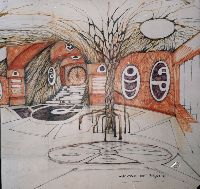The Metamorph
Terror from a doomed planet -a planet of death, despite advanced scientific knowledge, but a new life for a beautiful girl who has learned the secrets of molecular transformation. ITC summary
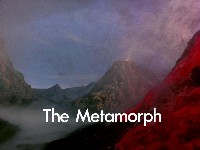
- First draft script titled The Biological Soul, featured Year One cast
- Second draft script titled The Biological Computer, 22 December 1975 (introduced Maya)
- Revised draft script titled The Biological Computer, 5th January 1976
- Shooting script titled The Metamorph, 19 January 1976
- Filming began on Monday 26th January 1976, and was scheduled for 13 days, but overran to 16 days, finishing on Monday 16th February 1976. Some shots were completed on the evening of Tuesday 17th February.
- The first lion employed was uncontrollable. The second was also uncooperative- it had toothache. The third was tame, but too friendly: it put its paws on the still photographers' shoulders. (see also story in The Making Of Space:1999 by Tim Heald p29)
- This should have been the first episode shown of the second series. This wasn't always the case. It was shown second in Canberra, Australia (CTC7 9th September 1977, after The Mark of Archanon on 2nd September).
- Edited into the 1982 compilation movie Cosmic Princess
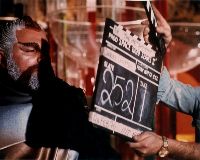
- The Psychon ship was built in two scales, 122cm and 66cm. The larger model is built around the tank of a Hoovermatic vacuum cleaner and was built as an ad hoc model after Year 1 by Martin Bower.
- The graveyard reused a number of ships from other episodes. Note only two are bigger than the 44" Eagles, and some are tiny (for instance, the Altares probe in the foreground). However, the graveyard is only seen in 4 brief scenes and is shrouded in mist, so the scale problems are not too obvious. More details
- In addition, a larger scale Eagle leg (69cm x 63cm) was built by Martin Bower for one shot of the graveyard.
- The rear motors of the first Eagle model have been altered to fire freon gas. Both the first and second 44" Eagles serve as the booster Eagle for different shots.
- Shots of an evading Eagle were reused from The Last Sunset (also seen in War Games and The Infernal Machine).
- The new Moonbase Alpha laser battery appears. Also note the outbuildings nearby: one is the Breakaway roundhouse, another is the Altares probe (also seen in the planet graveyard, from Into Infinity). The laser batteries also appear in The Exiles, Seed of Destruction, The Beta Cloud, The Bringers of Wonder, and The Dorcons.
- A revolving radar dish is used for one scene (it is actually a Year 1 gravity tower, modified originally as an antenna for the Altares from Into Infinity).
- The volcanoes were 1.5m high, made from a hollow frame of chicken wire covered in burlap and splashed with quick setting polyurethane foam, with peat moss as boulders. The lava was red paint with polystyrene chips, with much dry ice and titanium tetrachlorine providing the smoke.
- Psychon ship model photos
- Library Special Effects
- Original score by Derek Wadsworth, recorded Wednesday 17th March 1976 at Olympic Sound Studios, Barnes.
- ITC Music Cue Sheet
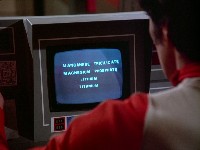
- The geology readout comprises: Manganese trisilicate (MnSiO8, a valid mineral), Magnesium Phosphate (a rare chemical), Lithium (an element that doesn't occur on its own, but can occur for instance in clays), titanium (another element that doesn't occur by itself, but in minerals such as rutile and illmenite, found in magmatic intrusions that have undergone segregation, such as gabbros and diorites).
- Titanium is not rare, it comprises 0.6% of the Earth's crust and is more common on the Moon. Refining it is difficult- the dioxide is reduced in an electric furnace. Due to its high strength, low density and corrosion resistance, it is a common structural material in ships, aircraft and spacecraft (and is named as a constituent of the Eagles in Space Brain). As titanium dioxide it is used as a white pigment in paint. The highly toxic titanium tetrachloride (TiCl4) was used to make the wispy smoke in this episode's SFX scenes. The only use that might be referred to as "life support systems" is as prosthetic devices. Perhaps the space warp severely depleted Alpha's stock of artificial limbs.
- Psychon's atmosphere is said to be "Carbon, hydrogen, nitrogen; breathable." This combination isn't- there is no oxygen. Carbon is a solid (graphite, diamond); in the atmosphere it would be present as carbon dioxide, CO2. Hydrogen is a gas but very rare in the atmosphere; it does occur in the form of water, H2O, however.
- Planets tend to cool down, not heat up (entropy). Localised areas may experience increased volcanic activity as, for instance, plate tectonics forces continents to collide. It is possible the configuration of continents on Psychon includes relatively little inhabitable land mass, which has diminished over time due to continental drift.
- Metamorphosis is found in many invertebrates (insects) and amphibians (such as frogs) when the infant larval stage changes to the adult form. However, molecular transformation evidently involves a fundamental reorganisation of molecules, which would be very difficult to control in a living organism and is impossible in energetics terms (in particular, as the transformation would involve energy, each transformation would have to be into a smaller animal, so Maya would shrink rapidly).
- Mentor's plan is to transform the planet to "the beautiful world it once was". Volcanic ashes are actually full of nutrients, enriching soils around the volcanoes which in turn allows highly productive agriculture (if the volcanism isn't continuous).
- The energy of a brain is about 5 watts of electricity, so Mentor has chosen a very inefficient way of feeding power to Psyche.
- The mining methods (to extract the metal for Psyche's physical being) are very primitive, using picks and shovels in small, cramped caves. Mentor needs to invest in modern mining tools and techniques.
- The robot Eagle's flight to the planet takes ten minutes. Psychon must be very close to the moon, or the robot Eagle is exceptionally fast.
- Blowing up Psychon would produce a vast amount of rocky debris, an intense meteorite storm which could strike the Eagle and the Moon.
342 days after leaving Earth orbit (Sun 20 Aug 2000)
Population 297. 3 fatalities, Ray Torens, Lew Picard, Eagle pilot. One addition, Maya, so the population at the end of the episode is 295.
- There is no explanation of any of the changes since Year One: Command Centre, new uniforms, the appearance of Tony and the disappearance of Bergman, Morrow and Kano.
Alpha Technology:
Eagle 1 (Fraser, destroyed with planet); 4 (Koenig's rescue, with booster pod and spine boosters); 5 and 6 (combat). Three Eagles are destroyed- Eagle 1, the remote bomb Eagle, and an Eagle over a launch pad.
- The booster pod is seen prominently on Eagle 4 (represented in different shots by both 44 inch filming models).
- A different sort of strap on booster is seen in New Adam, New Eve.
Lion, Koenig (not a complete transformation in the final cut), Alsatian dog, turtle dove, kestrel, "gorilla". In the original cut, an orange tree (seen in her eye, a silver tree). Note that Maya transforms directly from the dog into the gorilla. A photo of the orange tree appeared in the US TV Guide dated 19 March 1977.
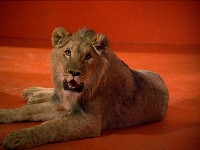
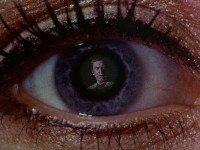
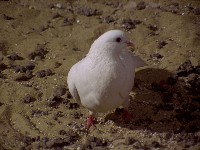
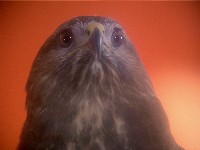
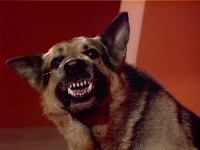
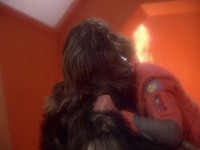
Psychon. According to Bringers Of Wonder, it has a moon; although there is no air, a bipedal animal called the larren lives there.
Aliens:
Mentor and Maya, Psychons. In Dorzak we meet another Psychon. There are "diverse species" in the caves.
Props:
Footage:
- Shot of boosters being added to an Eagle in a hangar are reused in The Exiles
- Shot of two Alphans in jumpsuits running down a corridor are reused in The Mark Of Archanon
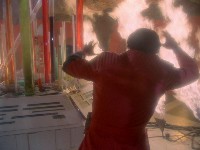
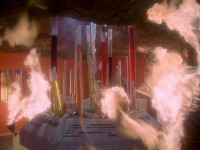
The gas pipes used to create the fire effects can be seen on the floor in several shots. Thanks to Patrick Hill.
An earlier cut of this episode was shown in US previews in August 1976. See Year 2 titles and Metamorph cut scene.
- The original scripted date for the episode was 108 days (on screen it is 342 days).
- Freiberger probably picked the name Maya from the Central American Indian civilisation. By coincidence the name is also a Sanskrit word meaning wizardry or illusion, and a concept in Hindu philosophy and religion of divine powers used to make humans believe in illusions, and by extension, the illusory world of the senses.
- There is also a Maia in Greek mythology, a mountain-nymph in Arkadia who was the mother of Hermes.
- Mentor in Homer's Odyssey was a friend of Odysseus and guardian of his household; hence the modern form of a wise adviser.
- Psyche in Greek mythology was the mortal wife of Eros; in Roman mythology the lover of Cupid. She is regarded as a personification of the human soul.
- Maya's role is a more direct replay of Pocahontas (real name Matoaka, later Rebecca Rolfe, c.1595-1617). She was the daughter of Powhatan, king of the Algonquian Indian tribes in Virginia, North America. In 1607, aged 12, she stopped her father from killing the British settlers, in particular their leader, Captain John Smith. She married John Rolfe, another of the settlers, in 1614. They had a son in 1615, and in 1616 she returned with him to England. She died in 1617, aged about 22.
- Changing into animals is scientifically dubious, but has a long history in myth and fiction, including Greek gods, werewolves, vampires and characters in Kafka, T.H. White's The Sword in the Stone, Terminator 2, Star Trek Deep Space Nine and the Harry Potter books (the Animagi). Koenig holding the rapidly changing Maya during the Psychon fire echoes a tale in Homer's Odyssey: Menelaus tells how he captured and held the god Proteus, despite the god transforming into various forms including a lion, a serpent and a tree.
- The examples of metamorphosis demonstrated by Mentor (using Psyche) are very different to Maya's. We learn later in the series that Maya can only transform herself into organic beings, such as animals or plants, for up to an hour. Mentor never transforms himself, but he can turn a rock into a spaceship or a humanoid overseer, and make the lunar surface explode. His plan is to transform the volcanic surface into whatever Psychon looked like before. The transformations involve inorganic and organic forms and are not time constrained. Maya's transformations seem completely different.
- The script has echoes of the first series (Mentor's "I only wanted to do good" recalls the hubris of Queller and other episodes) but has a strong humanist theme of the second series ("We'll determine our own destinies!")
- Emma Porteous design for Maya's dress states: "Grey sheath dress of grey sequins - based on transparent net - re-embroidered with grey sequins - trimmed with grey ostrich feathers"
- Lew Picard was Louis Picard in the French version of this episode
|
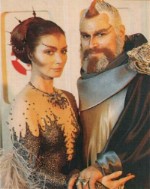
Numerous publicity photos of Maya and Mentor in Command Center were taken by Michael Putland; in the episode neither visits Alpha
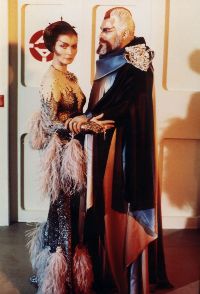
|
- Novelised in Planets Of Peril by Michael Butterworth published by Star (UK paperback), Allan Wingate (UK hardback), Warner (US), Bastei (Germany), Mikasa (Japan) and re-edited in Year Two (Powys, 2006).
- Novelised in Gli Alieni Dai Mille Volti by Gianni Padoan (AMZ).
- A short story version is in the British 1977 Annual (online here)
- Charlton Comics did two comic strip versions in their magazine, issue 8, and color comic, issue 7.
- Blam Classics Remastered did a revised, colourised version of the Gray Morrow Charlton adaptation in issues 1 and 2, and the omnibus print edition To Everything That Was
- UK video: Polygram volume 23 (1996)
- UK DVD: Carlton (2001)
- UK Blu-ray: Network Complete First Series (2010)
- UK Blu-ray: Network Complete Second Series (2015)
- US video: Columbia House volume 1 (1997)
- US laserdisc: Image Entertainment volume 13 (1991)
- US DVD: A&E (2002)
- US Blu-ray: A&E (2010)
- US Blu-ray: Shout! Factory (2019)
- Australia DVD: Magna Pacific (2003)
- France DVD: TF1 (2002)
- Germany video: Polygram volume 2 (1995)
- Germany DVD: EMS (2005)
- Germany DVD: Sunrise Entertainment / Crest (2013)
- Germany Blu-ray (SD): Crest (2012)
- Germany Blu-ray (HD): Fernsehjuwelen (2016)
- Japan DVD: Pioneer (2001)
- Italy DVD: Pulp Video (2004)
- Italy DVD: Collector's Edition Mondo Home (2007)
- Sixteen 12 produced a die cast Eagle with booster pod and spine boosters in Deluxe Eagle Gift Set (2006)
- Round 2 produced 1/48 spine booster (2020), and Eagle 4 (1:72 / 14 inch) model kit (2023)
External Links
![]() Year 2 - Episode 1
Year 2 - Episode 1 ![]()
